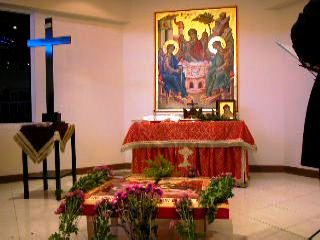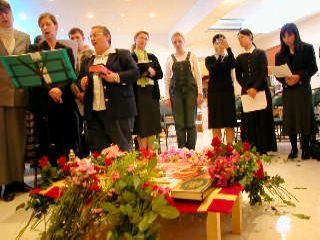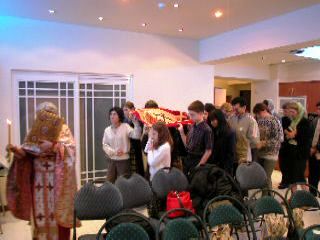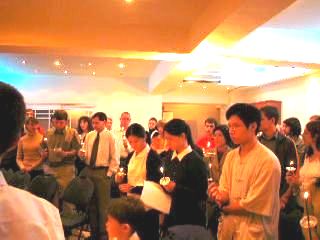 |
|
Altar and Epitaphios on Good Friday 2004 |
Pascha in Taiwan 2004*
Looking at an old issue of The Censer on the web the other day, I found two articles about our church and Pascha in Taipei in 2001 (The Censer, May, 2001). Three years later, the time seems appropriate to present readers with an update of the progress of the Holy Trinity Orthodox Church in Taipei, Taiwan.
Although I was in Taiwan three years ago, I did not attend the Paschal celebrations in 2001 because I had already signed up to be a proctor at the graduate entrance exams held at our university on that weekend, signed up before I even knew we had a church. However, I started attending a few weeks later and thus I, too, I remember those early days.
Those first liturgies were held in a local Catholic Church after our Catholic friends had finished their masses; in May 2001 we moved to rented quarters in Tien Mu, an area of Northern Taipei populated by a number of foreigners in addition to locals. The flat was a former kindergarten located on the ground floor of a seven-story apartment building. In addition to the cute animal images on the wallpaper, there was a small backyard, useful for processions on Pascha and other holydays. And it was very pleasant to eat together outside after Liturgy around the big table under the starfruit tree.
 |
|
Altar and Epitaphios on Good Friday 2004 |
However, the Tien Mu neighborhood was an old neighborhood populated by many traditional Buddhists. While friendly, none of the neighbors showed any interest in finding out more about our church. After a long time spent negotiating and securing funding, in March 2004 we moved to a Taipei suburb (台北縣新店市溪園路389之12號4樓 B8). Now that the Church has property, it can go through the legal registration process. More importantly, this neighborhood is populated primarily by younger, professional Chinese who may be more willing to explore new ideas. We plan to offer some public lectures and other activities in order to attract more people to get to know us. Meanwhile, we are in the process of decorating our church. On Good Friday, a large icon of the Holy Trinity arrived from Greece and now has pride of place right behind the altar.
We must attract new people because, after all, the purpose of this mission church is to introduce the Orthodox Church to the people of this island. Of those Chinese baptised so far, nearly all are Taiwanese women married to men from traditional Orthodox countries. Here we have a lot of work to do to attract the local Chinese population.
However, we cannot ignore those non-Chinese who still make up the majority of our congregation. A number are young Russians or Ukrainians who have come to Taiwan to study Chinese. Others, like me, have come to Taiwan for the longer or shorter term for professional reasons. Still others married Chinese spouses abroad and returned to Taiwan with them.
While some of those baptised Orthodox were active in their home churches, many were not. Perhaps some now come to socialize with their fellow-countrymen. Perhaps others have experienced true loneliness for the first time in a foreign land and turned to God. Still others may have found freedom of conscience away from the pressures of family and society. All of us need our church, too, and we foreigners who love the church we grew up with must be role models for our Chinese brothers and sisters.
 |
|
Singing the Lamentations on Good Friday |
This year Father Jonah was able to do all the services of Holy Week, and everyone in attendance had access to the texts in English and Greek, with the more familiar texts also in Chinese and Church Slavonic (the Internet is a great resource). While numbers were low (four to six) on Monday, Tuesday, Wednesday, Thursday morning, numbers increased for the Reading of the Twelve Gospels on Thursday evening, Good Friday Vespers and Lamentations, and Saturday morning Liturgy, swelling to well over 50 for the Resurrection Liturgy on Saturday evening.
For many of these services, Father Jonah asked the participants to take turns in reading the various psalms and texts. While this decision is made first because we do not all know how to sing all these pieces, or to sing them in the same way, I have come to see this reading as a good choice because in this way, all of us are participating and paying attention to the meaning of the texts. How much better this is than listening to some old psaltists singing as if they are auditioning for a place at the local opera house, while the minds of ordinary people wander because not only are they not participating, but they may not even understand any of the language as a first, second, or third language.
 |
|
Procession with the Epitaphios on Good Friday |
Good Friday evening we did both the Vespers and Lamentations. As Father Jonah tells us, “This is Jesus’ funeral,” and we are all participants in this very moving drama as we offer our flowers and join in the procession with the epitaphios. This year we sang all three of the staseis in English. For the children of a Greek-American family with us for a few years, this was the first time they had heard these verses in a language they understood. We also read the same texts in Chinese. Perhaps next year we may even sing some of them in Chinese.
At Pascha we use four languages: the Canons of the Resurrection are read in English, Chinese, and Church Slavonic (some of these sung), while Father Jonah sings some of them in Greek. “Christ is Risen” is done alternately in all four languages all through the Paschal season. Thus all of our congregation can participate if not in their first language, at least in their second.
 |
|---|
|
Paschal Liturgy, holding lighted candles |
I remember those early days when Father Jonah would say, “Sing something”. No longer. Now we have a small group of singers—three sopranos, one alto, one bass—and we do all the Liturgy, including the prescribed troparia and kontakia for the various Sundays and feasts. Most of our pieces are based on what is sung in Greek Orthodox churches in the USA, but we sing primarily in English, with some occasional songs also in Church Slavonic or Greek. Other pieces are of Russian or Carpathian origin. Most important, what we choose has to be singable by ordinary people—and our people do sing along.
While English is our best choice now as virtually all of our members and visitors have at least some moderate ability in English, we must, sooner rather than later, switch to Chinese as our major language of worship. This will not be easy, as we non-Chinese familiar with the Orthodox way of singing and doing the Liturgy will have to lead the way. The initial result will be a not-too-natural but necessary step similar to that we experienced previously when our Church Slavonic or Greek versions were first translated into English singing. But we have to begin. For the near future, we will probably continue to use three to four languages to reflect our congregation.
|
|
|
After Paschal Liturgy, enjoying God's blessings |
In summer 2003, several of our non-Chinese members went back to visit their homelands. Upon their return, Russians, Ukrainians, and Americans were saying the same thing: our church in Taipei is our real church. No one worries about your social class or nationality or the state of your wardrobe but instead inquires warmly about how you are doing. We know that the Holy Spirit is here with us, that we have something very special. But we are a mission church and we cannot be complacent. Especially during this glorious season of Pascha, we must spread our joy to our Chinese friends and colleagues who, being primarily middle class, may have all physical comforts but still be unhappy or dissatisfied with their lives and seeking something better. In this prosperous democracy, it is not our money that is needed, but our time, our love, and our prayers.
1. A modified version of this essay appears in The Censer, May, 2004, pp. 14-20.
2. The Censer is a monthy publication of the Orthodox Metropolitanate of Hong Kong and Southeast Asia. Issues can be found at http://www.cs.ust.hk/faculty/dimitris/metro/CENSER.html
3. The Epitaphios (Plaschanitsa is Slav usage) is an image of the dead Jesus painted or embroidered in ikon style upon a cloth. During the Good Friday services, the priest and people walk in procession with the epitaphios as did Joseph of Arimathea when he carried the body of Christ for burial in a tomb. The low table here represents the tomb and, appropriately, flowers are placed around it to honor the dead Jesus.
4. Enjoying God's blessings--The seven to eight weeks before Pascha (Easter), called Lent in English, we remember that Christ suffered and died for us. It is a time of prayer and fasting as we prepare ourselves for the celebration of the Resurrection. During this time believers do not eat meat or eggs or any other dairy products. Thus it is a real feast on rich foods after two months without them. On the left, roast lamb is being carved. In the middle, red cooked eggs are ready to be eaten, red symbolizing the suffering of Christ.
For more information about Holy Trinity Orthodox Church, Taipei, go to http://theological.asia/